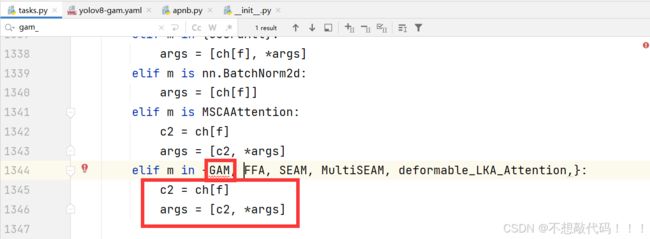爆改YOLOv8 | yolov8添加GAM注意力机制
1,本文介绍
GAM(Global Attention Mechanism)旨在改进传统注意力机制的不足,特别是在通道和空间维度上的信息保留问题。它通过顺序的通道-空间注意力机制来解决这些问题。以下是GAM的关键设计和实现细节:
-
通道注意力子模块:
- 3D排列:使用3D排列来在三个维度上保留信息,这种方法有助于捕捉更多维度的特征。
- 两层MLP:通过一个两层的多层感知机(MLP)增强跨维度的通道-空间依赖性,提升了模型对复杂特征的学习能力。
-
空间注意力子模块:
- 两个卷积层:采用两个卷积层融合空间信息,增强空间特征的学习,而不是使用最大池化操作,避免了可能导致信息损失的操作。
- 分组卷积与通道混洗:通过分组卷积和通道混洗,GAM在ResNet50中避免了显著的参数增加,这有助于减少计算开销和内存占用。
-
性能提升:
- 在不同网络架构上的应用:GAM在多种神经网络架构上都展示了稳定的性能提升,尤其在ResNet18上,GAM在参数更少的情况下展现了比ABN(Adaptive Bottleneck Network)更好的性能和效率。
GAM通过这些设计增强了对全局信息的捕捉能力,并在保持高效性的同时,显著提高了模型的表现。
以下为GAM模型结构图
关于GAM的详细介绍可以看论文:https://arxiv.org/pdf/2112.05561v1.pdf
本文将讲解如何将GAM融合进yolov8
话不多说,上代码!
2,将GAM融合进YOLOv8
2.1 步骤一
首先找到如下的目录'ultralytics/nn/modules',然后在这个目录下创建一个attention.py文件,文件名字可以根据你自己的习惯起,然后将GAM的核心代码复制进去。
# gam核心代码
import torch
import torch.nn as nn
'''
https://arxiv.org/abs/2112.05561
'''
__all__ = (
"GAM",
)
class GAM(nn.Module):
def __init__(self, in_channels, rate=4):
super().__init__()
out_channels = in_channels
in_channels = int(in_channels)
out_channels = int(out_channels)
inchannel_rate = int(in_channels/rate)
self.linear1 = nn.Linear(in_channels, inchannel_rate)
self.relu = nn.ReLU(inplace=True)
self.linear2 = nn.Linear(inchannel_rate, in_channels)
self.conv1=nn.Conv2d(in_channels, inchannel_rate,kernel_size=7,padding=3,padding_mode='replicate')
self.conv2=nn.Conv2d(inchannel_rate, out_channels,kernel_size=7,padding=3,padding_mode='replicate')
self.norm1 = nn.BatchNorm2d(inchannel_rate)
self.norm2 = nn.BatchNorm2d(out_channels)
self.sigmoid = nn.Sigmoid()
def forward(self,x):
b, c, h, w = x.shape
# B,C,H,W ==> B,H*W,C
x_permute = x.permute(0, 2, 3, 1).view(b, -1, c)
# B,H*W,C ==> B,H,W,C
x_att_permute = self.linear2(self.relu(self.linear1(x_permute))).view(b, h, w, c)
# B,H,W,C ==> B,C,H,W
x_channel_att = x_att_permute.permute(0, 3, 1, 2)
x = x * x_channel_att
x_spatial_att = self.relu(self.norm1(self.conv1(x)))
x_spatial_att = self.sigmoid(self.norm2(self.conv2(x_spatial_att)))
out = x * x_spatial_att
return out
if __name__ == '__main__':
img = torch.rand(1,64,32,48)
b, c, h, w = img.shape
net = GAM(in_channels=c, out_channels=c)
output = net(img)
print(output.shape)2.2 步骤二
首先找到如下的目录'ultralytics/nn/modules',然后在这个目录下找到init文件,在init中添加如下代码.
from .attention import (
GAM,
)同时在init.py中的如下位置添加GAM
2.3 步骤三
在task.py中导入GAM
2.3 步骤四
在task.py中添加如下代码.
到此注册成功,复制后面的yaml文件直接运行即可
yaml文件
# Ultralytics YOLO , AGPL-3.0 license
# YOLOv8 object detection model with P3-P5 outputs. For Usage examples see https://docs.ultralytics.com/tasks/detect
# Parameters
nc: 80 # number of classes
scales: # model compound scaling constants, i.e. 'model=yolov8n.yaml' will call yolov8.yaml with scale 'n'
# [depth, width, max_channels]
n: [0.33, 0.25, 1024] # YOLOv8n summary: 225 layers, 3157200 parameters, 3157184 gradients, 8.9 GFLOPs
s: [0.33, 0.50, 1024] # YOLOv8s summary: 225 layers, 11166560 parameters, 11166544 gradients, 28.8 GFLOPs
m: [0.67, 0.75, 768] # YOLOv8m summary: 295 layers, 25902640 parameters, 25902624 gradients, 79.3 GFLOPs
l: [1.00, 1.00, 512] # YOLOv8l summary: 365 layers, 43691520 parameters, 43691504 gradients, 165.7 GFLOPs
x: [1.00, 1.25, 512] # YOLOv8x summary: 365 layers, 68229648 parameters, 68229632 gradients, 258.5 GFLOPs
# YOLOv8.0n backbone
backbone:
# [from, repeats, module, args]
- [-1, 1, Conv, [64, 3, 2]] # 0-P1/2
- [-1, 1, Conv, [128, 3, 2]] # 1-P2/4
- [-1, 3, C2f, [128, True]]
- [-1, 1, Conv, [256, 3, 2]] # 3-P3/8
- [-1, 6, C2f, [256, True]]
- [-1, 1, Conv, [512, 3, 2]] # 5-P4/16
- [-1, 6, C2f, [512, True]]
- [-1, 1, Conv, [1024, 3, 2]] # 7-P5/32
- [-1, 3, C2f, [1024, True]] # 8
- [-1, 1, GAM, []] # 9
- [-1, 1, SPPF, [1024, 5]] # 10
# YOLOv8.0n head
head:
- [-1, 1, nn.Upsample, [None, 2, 'nearest']]
- [[-1, 6], 1, Concat, [1]] # cat backbone P4
- [-1, 3, C2f, [512]] # 13
- [-1, 1, nn.Upsample, [None, 2, 'nearest']]
- [[-1, 4], 1, Concat, [1]] # cat backbone P3
- [-1, 3, C2f, [256]] # 16 (P3/8-small)
- [-1, 1, Conv, [256, 3, 2]]
- [[-1, 13], 1, Concat, [1]] # cat head P4
- [-1, 3, C2f, [512]] # 19 (P4/16-medium)
- [-1, 1, Conv, [512, 3, 2]]
- [[-1, 10], 1, Concat, [1]] # cat head P5
- [-1, 3, C2f, [1024]] # 22 (P5/32-large)
- [[16, 19, 22], 1, Detect, [nc]] # Detect(P3, P4, P5)# 关于GAM添加的位置还可以放在颈部,针对不同数据集位置不同,效果不同
不知不觉已经看完了哦,动动小手留个点赞吧--_--




